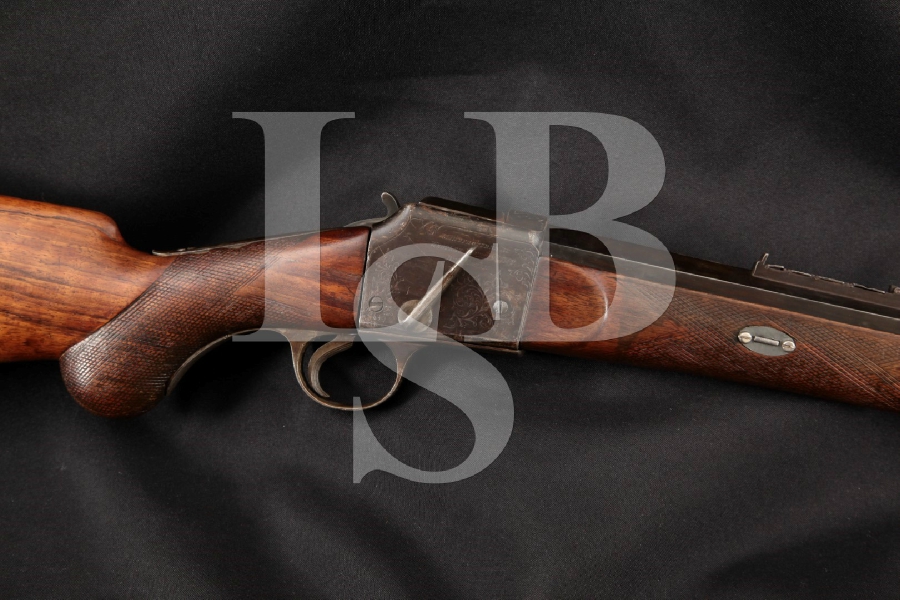
Westley Richards Field’s Patent of 1877 Sporting Carbine Model, Engraved Blue 25” Single Shot Falling Block Rifle, MFD 1882 Antique
LSB#: 161020LH42
Make: Westley Richards
Model: Patent Model of 1877 Falling Block Sporting Rifle
Serial Number: 1211
Year of Manufacture: 1882
Caliber: .45, 1 ½ Case
Action Type: Single Shot, Falling Block, Self-Cocking Exposed Hammer Rifle
Markings: The left of the barrel is marked “1000”, the top is marked “HENRY’S PATENT RIFLING / CARBINE / 1 ½ CASE”, the underside is marked “WR 237407 / 2 / POWLER / 1.82 N.A & A. CO LD / 52”, the serial number, and 3 Birmingham proof marks. The front of the receiver is marked with the serial number and assembly number 1000. The underside of the receiver has the serial number, the top of the forend has “1000”. The left of the receiver is marked “FIELD’S PATENT / NO 1927 / 1877”, the top is marked “1882” in triangle, the right is marked “MANUFACTURED BY / WESTLEY RICHARDS & CO. / BIRMINGHAM”. The receiver has nice scroll engraving, found again on the trigger guard and lower tang.
Barrel Length: 25”, Octagonal, Heavy Profile
Sights / Optics: The front sight is a ‘globe’ style cylindrical base with a small beaded post, the base is dovetailed onto the slide. The rear sight is a “V” notched standing leaf, with four other “V” leafs in front for ranges of 100 to 400 meters. Sitting yet ahead of this is a “V” leaf and flip-up ladder, with adjustment from 400 to 1200 meters. The top of the octagonal barrel is finely checkered for glare reduction.
Stock Configuration & Condition: The stocks are checkered walnut. The forend has a wooden nose cap and wrap-around checkers; the checkers are faded, it looks like the stock was sanded and re-varnished at some point, there is a chip loss on the right of the nose cap. The escutcheons for the wedge come off freely with the wedge, there are no screws present. The butt stock has a rounded and checkered pistol grip, a swivel bar is installed on the belly, the forward swivel is on the ram rod loop. The stock has also been sanded down, with a varnish finish. There are multiple repaired and un-repaired cracks around the wrist and tangs, the right of the upper tang has chip losses. There are compression marks on the surfaces, the wood has poor fit to the metal in areas. The LOP measures 14 1/8” from the front of the trigger to the back of the metal butt plate; the plate has a small circular door with a strong spring. The metal has been cold blued, the fit to wood is off, the pate is in about Fair to Good condition. The stocks rate in about Fair overall condition.
Type of Finish: We believe the surfaces have been cold blued.
Finish Originality: The finish is not original
Bore Condition: The bore is dark and the Henry’s Patent rifling is still highly defined. There is light to moderate depth erosion in scattered areas.
Overall Condition: This rifle retains about 0% of its original metal finish. The surfaces have been cold blued, with some areas of exposed bare metal. The surfaces have spots of surface erosion and heavier scuffing. Deeper erosion is found on the front sight and near the muzzle. Three of the leafs on the sight base are loose and do not stay up very well, the 100 meter leaf retains position well. Heavy marks are found on the front swivel and the ram rod loop. Please see our pictures of this rifle. The screw heads are disfigured in some cases, most have mild tooling. The markings are slightly faded in areas but are legible unless otherwise noted. Overall, this rifle rates in about Fair Plus to Good condition.
Mechanics: The action functions correctly. The action is opened by pressing on the right side lever, patent no. 1927, of 1877. The hammer has a half cock position, the spring is south of ‘strong’ but still works. We have not fired this rifle. As with all previously owned firearms, a thorough cleaning may be necessary to meet your maintenance standards.
Box, Paperwork & Accessories: None, NO RAM ROD IS INCLUDED
Our Assessment: Westley Richards & Co. began way back in 1812 and were recognized for their valuable advances in the evolution of firearms, including the 1881 Falling Block patent which is what we have here on this rifle. The action opens with a right side lever, exposing the breech; when pushed all the way down, an ejector kicks spent brass out. This rifle was made in 1882 in the 25” carbine configuration, in .45 1 ½ Case, which would have paired well with the multi-leaf and ladder sighting system. These rifles were sold to hobbyists who wanted to go on safari and not have to ram a ball down a bore after every shot. A system like this would have been on the cutting edge and top of every savvy gentleman’s wish list, with its engravings and beautiful construction. The Henry Patent rifling is still highly formed and the history of this rifle almost certainly includes dropping some animals; otherwise, it would have been an accepted platform for distance shooting.

